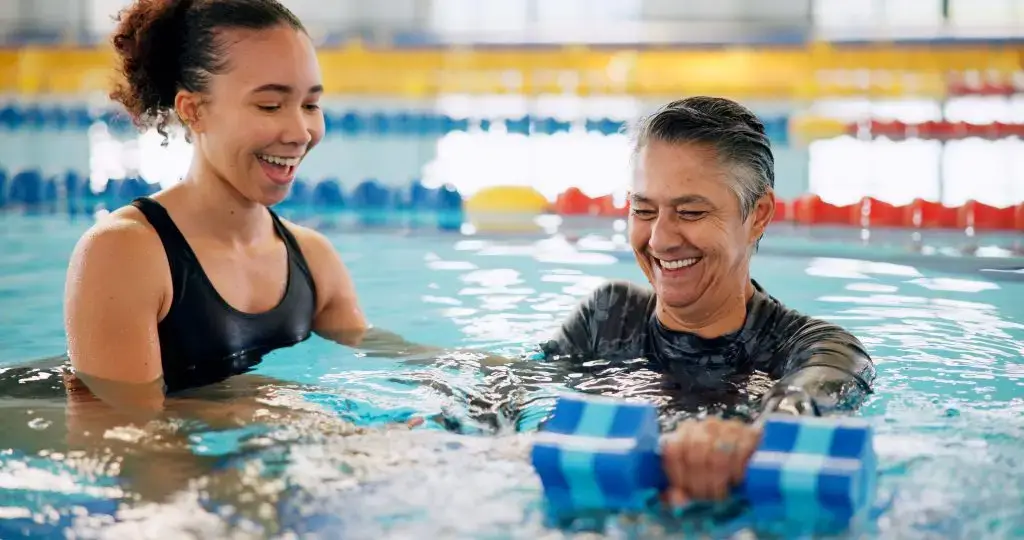For anyone recovering from an injury or surgery, water-based physical therapy can be a game-changer. The soothing properties of water not only help alleviate pain but also support mobility, making it an excellent choice for those on the mend as well as those who could benefit from a little extra support during physical therapy exercises.
What is aquatic physical therapy?
Aquatic therapy, also known as water physical therapy or pool therapy, is a rehabilitation method that uses the properties of water to aid in physical recovery. Utilizing specialized pools, this form of therapy leverages water’s buoyancy, resistance, and even warmth to facilitate movement and healing.
The pool provides a supportive environment that reduces stress on joints and muscles, allowing individuals to perform movements that may be difficult out of the water. This makes aquatic therapy an ideal choice for those dealing with mobility issues or joint pain.
Aquatic therapy patients might engage in movements such as walking or jogging in place, leg swings, and arm lifts, all aimed at improving mobility and strength. These exercises are often combined with balance and coordination activities to enhance overall stability.
Therapists may also use manual techniques like stretching or joint manipulation, which are more comfortably performed in water. The water’s warmth aids in relaxing muscles, making these techniques gentler on stiff joints. Additionally, therapists often utilize resistance equipment, such as water weights or noodles, to enhance the intensity of exercises and facilitate muscle development.
One of the key elements of aquatic therapy is its adaptability. Sessions are customized to each individual’s condition, goals, and comfort level. This personalized approach ensures that every patient gets the maximum benefits from their therapy, progressing at a pace that suits their recovery.
Benefits of water therapy
Water therapy has been in use in various forms for centuries. From ancient peoples seeking out hot springs to treat disease to modern water aerobics classes, the water has always been a symbol of and partner in healing. Evidence-based benefits we see in today’s pool therapy treatments include:
- Relaxation and reduced stress
- Supportive, low-impact exercise
- Gentle joint manipulation
- No fall risk
Conditions aquatic therapy can treat
Water physical therapy is incredibly versatile, offering benefits across a range of conditions. It is particularly effective for:
- Gait and mobility disorders
- Chronic pain
- Coordination and balance issues
- Arthritis
- Endurance training
- Recovery from injury or surgery (when possible)
Coordination and balance
Improving balance and coordination is crucial for those recovering from neurological conditions or injuries. Water resistance offers a safe environment to practice balance-enhancing exercises without the fear of falling.
Endurance training
Patients looking to enhance their endurance will find aquatic therapy challenging in a good way. Water’s resistance increases the effort required for movements, effectively building stamina over time while minimizing fatigue risk.
Recovery from injury or surgery
Aquatic therapy is a gentle yet effective option for post-surgery or injury recovery if you’re cleared to be submerged in water. The supportive nature of the pool allows for early mobilization and active rehabilitation, promoting healing and reducing recovery time without overexerting the body.
What to expect from aquatic therapy
Aquatic physical therapy is one of many modalities we can use to customize your treatment plan. Many physical therapy exercises, stretches, and movements can be done in or out of the water, leading to further tailored plans for your unique therapeutic needs.
Sessions are structured like any other workout: with a warm-up, exercise phase, and cool-down period. And best of all, you don’t need to know how to swim to participate and reap the benefits of aquatic therapy.
Get started with aquatic therapy today
Aquatic physical therapy offers a unique and effective path to recovery for those dealing with injuries or mobility issues. By harnessing the power of water, this therapy provides a safe, supportive, and enjoyable environment for healing. Patients can benefit from improved mobility, reduced pain, and enhanced quality of life through this innovative approach.
If you’re ready to explore the benefits of water therapy, consider reaching out to one of our nearby locations by phone or requesting an appointment online. Our experienced team is here to help you get the assistance and guidance you need to recover fully and quickly.

